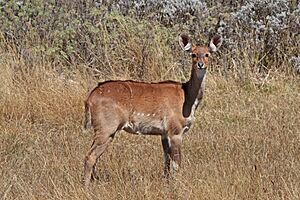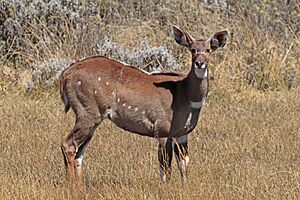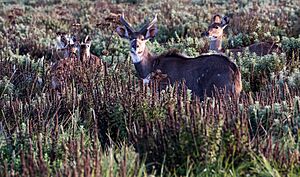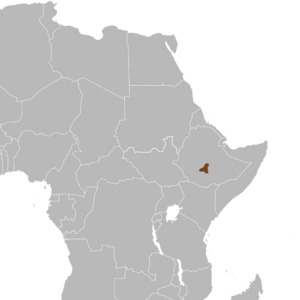Mountain nyala facts for kids
Quick facts for kids Mountain nyala |
|
|---|---|
 |
|
| Male | |
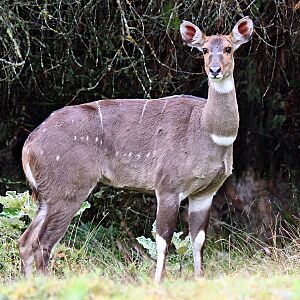 |
|
| Female both Bale Mountains National Park, Ethiopia |
|
| Conservation status | |
| Scientific classification |
The mountain nyala (Amharic: የተራራ ኒዮላ), also called the balbok, is a large antelope. It lives in high-altitude forests in a small part of central Ethiopia. This animal is a unique species, meaning it doesn't have any known subspecies. An English naturalist named Richard Lydekker first described it in 1910.
Male mountain nyalas are usually 120–135 cm (47–53 in) tall at the shoulder. Females are a bit smaller, standing 90–100 cm (35–39 in) tall. Males can weigh 180–300 kg (400–660 lb), while females weigh 150–200 kg (330–440 lb). Their fur is grey to brown. It has two to five faint white stripes along its back and six to ten white spots. They also have white marks on their face, throat, and legs. Males have a short, dark crest, about 10 cm (3.9 in) high, running along their back. Only male mountain nyalas have horns.
Mountain nyalas are very shy and try to avoid humans. They sometimes gather in small groups of four to five animals. Males do not protect a specific area as their own. These antelopes mostly eat leaves and branches, but sometimes they eat grass too. Females start having babies when they are two years old. Males also become able to have offspring around this age. Pregnancy lasts for eight to nine months, and usually one calf is born. Mountain nyalas live for about 15 to 20 years.
Mountain nyalas typically live in mountain forests between 3,000–3,400 m (9,800–11,200 ft) high. Because of human settlements and many farm animals, they have been forced to live in higher heath forests, above 3,400 m (11,200 ft). These animals are only found in the Ethiopian Highlands, east of the Rift Valley. About half of all mountain nyalas live in the Gaysay area, which is part of the Bale Mountains National Park. The mountain nyala is listed as an Endangered species by the International Union for Conservation of Nature and Natural Resources (IUCN). It is also featured on the Ethiopian ten cents coin.
Contents
About the Mountain Nyala
The mountain nyala was first described by English naturalist Richard Lydekker in 1910. Its scientific name is Tragelaphus buxtoni. This species belongs to the group Tragelaphus, which is part of the Bovidae family (which includes cattle, goats, and sheep).
The mountain nyala was first brought to England in 1908 by Major Ivor Buxton. The species was named after him. Major Buxton had been on a hunting trip in Ethiopia. He showed a specimen he had shot to a British taxidermist named Rowland Ward. Ward then told Lydekker about this new discovery. The mountain nyala was the last large antelope to be discovered in Africa. Its spiral horns and white markings showed it was a type of Tragelaphus.
Scientists have studied the mountain nyala's family tree. In 2005, a study looked at the DNA of nine Tragelaphus species. The results showed that the mountain nyala is closely related to the bushbuck, sitatunga, and bongo.
What Does a Mountain Nyala Look Like?
The mountain nyala is a large animal, and males and females look different. This is called being sexually dimorphic. Males are about 240–260 cm (94–102 in) long from head to body. Females are shorter, around 190–200 cm (75–79 in) long. As mentioned, males are taller (120–135 cm (47–53 in)) and heavier (180–300 kg (400–660 lb)) than females (90–100 cm (35–39 in) tall, 150–200 kg (330–440 lb)). Their bushy tail is 20–25 cm (7.9–9.8 in) long and reaches their heel. They have large, sensitive ears lined with white hair.
Their fur is grey to brown. They have two to five faint white stripes on their back and six to ten white spots. White markings are also on their face, throat, and legs. A clear white V-shape between their eyes and a white patch on their throat are easy to spot. Their chest and rump are white. The lower parts of their legs are pale, with clear white spots just above their hooves.
Young male mountain nyalas have fawn-brown fur. It gets darker as they get older, turning charcoal grey in old males. Males have a short, dark crest, about 10 cm (3.9 in) high, running from their neck to their tail. The texture of their fur can change with the seasons. Females look similar to a red deer hind in size. Young females are bright reddish-brown. Older females are as grey as young males. Females have two pairs of nipples.
Horns
Only male mountain nyalas have horns. The longest horn ever recorded was 188 cm (74 in) long. Horns start growing as small cream-colored bumps when a calf is about six months old. They grow in a spiral shape and reach their full size by two years of age. The horns usually have one or two spirals. Some males have two and a half turns. The final shape of the horns can vary. They might form clear spirals or spread out like a lyre, similar to an impala's horns. Growth rings can be seen on the horns, but it's hard to tell how old the animal is from them. Even as they get older, the tips of the horns stay cream-colored.
The mountain nyala looks a bit like the greater kudu. Both have white spots on their sides and spiral horns. However, the greater kudu is taller and paler. Its horns also have two to three spirals, and the tips are farther apart. The mountain nyala is also similar to the nyala, but the nyala is smaller. The nyala also has a fringe of long hair on its throat and neck. The nyala's horns are similar but thinner and narrower.
Life and Habits
Mountain nyalas are shy and avoid people. They spend the night at the edge of forests, feeding for part of the time. To avoid humans, they often travel at night. In the morning and late afternoon, they come out to eat in grasslands. When it's very hot or cold, they hide in forests and thick bushes. They might eat during the middle of the day, but they also take breaks to rest. They tend to come out when it's cloudy or raining. In the dry season (November to March), when grasslands are poor, they travel to wooded areas with lots of heath plants.
Mountain nyalas sometimes gather in small groups of four to five animals. However, groups of up to 100 have been seen in the Bale Zone. These large groups are made up of several family units that join and leave. The size of these groups depends on the season, habitat, and time of day. Groups of females and young often include adult females with their calf from the previous year and a new calf. These groups might be led by adult males if there are females ready to breed. Groups of non-dominant adult males and young males, called bachelor herds, can have up to 13 individuals. Mixed-sex groups can also form. Older males often live alone, but they might visit female herds to find females ready to breed. There is a pecking order among both males and females.
Males do not protect a specific area as their own. Their home ranges cover 15–20 km2 (5.8–7.7 sq mi) in the wet season. Females and young animals use much smaller areas, about 5 km2 (1.9 sq mi) in the wet season. In the dry season, both males and females use larger areas. Males often wrestle using their horns. Mountain nyalas are usually quiet. But they might make a "cough" sound if they see a possible danger. If the danger is more serious, they might make a low bark. The leopard is the main predator of the mountain nyala.
What They Eat
Mountain nyalas mainly eat leaves and branches (this is called browsing). Sometimes, they will eat grass (this is called grazing). They feed on low-growing herbs, bushes, shrubs, and general plant leaves. They might also eat lichens, ferns, and plants that grow in water. They especially like grasses during the early wet season. They pick up fallen leaves and use their horns to reach higher branches. Some of their favorite plants include Artemisia afra (African wormwood), Hypericum revolutum, Kniphofia foliosa, Solanum sessilistellatum, and Hagenia abyssinica leaves. They also like Alchemilla rotti, Helichrysum splendidum, and the lower leaves of Lobelia rhynchopetalum.
Reproduction and Life Cycle
Mountain nyalas breed throughout the year, but most births happen in December. Before and during the breeding season, adult males often join mixed-sex herds. Three or four males might try to mate with a single female. If they are of similar rank, they might perform circling displays. In these displays, males move slowly and stiffly, with their crest raised and tail up. They are less likely to get into aggressive fights, which are usually short if they happen.
Pregnancy lasts for eight to nine months. After this, a single calf is born. In the Bale Mountains National Park, calves are born all year round, but most are born from September to November. Calves stay hidden for the first few weeks after birth. They stay close to their mothers for almost two years. Young females might get pregnant around this time. Young males, as they mature by two years, are challenged by other males and leave their herds. The mountain nyala lives for about 15 to 20 years.
Where They Live
The mountain nyala usually lives in mountain woodlands at an altitude of 3,000–3,400 m (9,800–11,200 ft). The trees there include African juniper, Afrocarpus gracilior, and Olea at lower levels. Higher up, you find Hagenia abyssinica, juniper, and Hypericum revolutum. They often visit the edges of mountain grasslands at 2,800–3,100 m (9,200–10,200 ft). These areas are covered with Artemisia afra, Kniphofia, and evergreen Hypericum species.
Today, the large areas of woodland habitat have become smaller, broken up by farmlands. Human settlements and many farm animals have forced the mountain nyala to live in heath forests above 3,400 m (11,200 ft). These forests have plants like Erica arborea, Erica trimera, Hypericum, Euphorbia, and Helichrysum species. They might even be forced into afroalpine grasslands with Alchemilla and Festuca species, up to 4,300 m (14,100 ft). In the eastern parts of their range, mountain nyalas have been seen at lower altitudes, around 1,800–2,400 m (5,900–7,900 ft).
Mountain nyalas are only found in the Ethiopian Highlands, east of the Rift Valley. Their old range stretched from Mount Gara Muleta in the east to Shashamene and the northern Bale Zone in the south. About half of all mountain nyalas live in the 200 km2 (77 sq mi) area of Gaysay, in the northern part of the Bale Mountains National Park. Smaller groups live in Chercher, mountains like Chilalo in Arsi Zone, and western Bale. A study found that an area of 39.38 km2 (15.20 sq mi) on the southern side of the Bale Mountains is the best habitat for the mountain nyala.
Threats and Conservation

The biggest dangers to the mountain nyala are illegal hunting, loss of their habitat, and farm animals moving into their areas. Dogs also hunt their calves. More mountain farming and building at high altitudes also threaten them. People hunt the mountain nyala for its horns and meat. The meat is used in local medicine and to make nipples for traditional milk bottles. The impact of trophy hunting programs is not clear. Current hunting limits might not be sustainable in the long term. However, if managed well, trophy hunting could help protect this species.
The mountain nyala is listed as an Endangered species by the International Union for Conservation of Nature and Natural Resources (IUCN). It is not listed under the Washington Convention (CITES). Even though there are laws to protect the species, they haven't always been followed well. In 1991, there was a lot of trouble in Ethiopia. Many mountain nyalas were killed, and their population in the Bale Mountains National Park dropped to 150. After the Bale Mountains National Park, the small Kuni-Muktar Mountain Nyala Sanctuary was set up in 1990 as a second protected area. But by 1996, this sanctuary was badly affected by deforestation, poaching, farming, and land erosion. The mountain nyala populations soon disappeared from there.
In the 1960s, there were an estimated 7,000 to 8,000 mountain nyalas, possibly up to 12,500. This number dropped sharply to 2,000 to 4,000 in the 1980s. The population is still decreasing today. The mountain nyala is feared to be gone from the eastern and southern edges of its range. However, a few might still live in Chiro (Asebe Teferi) and the border between Bale and Sidamo, south of Kofele. Besides Gaysay, about 80 to 120 mountain nyalas live in the rest of the Bale Mountains National Park. A few hundred more live in areas near the national park.
Mountain Nyala and Humans
The mountain nyala is important in Ethiopian culture. Even though "nyala" is a South African word, many businesses in Ethiopia, like Nyala Motors, use it in their names. The nyala and mountain nyala often appear on walls, products, and tourist items. The mountain nyala is shown on the front of the Ethiopian ten cents coin.
Mountain nyalas are hunted by people, for example, by the Oromo people. The Oromo usually do not hunt these animals. However, on a day close to Easter, all able-bodied men go out on horses for a hunt.



